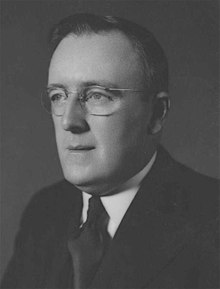Jack Beasley
|
The Right Honourable Jack Beasley |
|
|---|---|
 |
|
| Member of the Australian Parliament for West Sydney |
|
|
In office 17 November 1928 – 14 August 1946 |
|
| Preceded by | William Lambert |
| Succeeded by | William O'Connor |
| Personal details | |
| Born |
9 November 1895 Werribee, Victoria |
| Died | 2 September 1949 (aged 53) Darlinghurst, New South Wales |
| Resting place | Frenchs Forest Bushland Cemetery |
| Political party |
Labor (1928–31) Lang Labor (1931–36) Labor (1936–40) Lang Labor (1940–41) Labor (1941–46) |
| Occupation | Unionist |
John Albert "Jack" Beasley (9 November 1895 – 2 September 1949) was an Australian politician.
Beasley was born in Werribee, Victoria, but moved to Sydney with his family as a child. He had a primary education in Catholic schools then became an apprentice electrician. He worked as an electrician for the Sydney City Council, and became President of the Electrical Trades Union (ETU). From 1922 to 1928 he was President of the Trades and Labour Council of New South Wales (now Unions NSW). At this time he was under the influence of Jock Garden and was briefly a member of the Communist Party of Australia, but he soon left and became an influential member of the Australian Labor Party.
In 1928 Beasley was elected for the safe Labor seat of West Sydney. When Labor under Jim Scullin won the 1929 federal election, he became an Honorary Minister (minister without portfolio), but he resigned this position in 1931 in protest at the Scullin government's policies in response to the Great Depression. He became the leading lieutenant of the radical Premier of New South Wales, Jack Lang, and when Lang decided to break with the federal ALP Beasley resigned from the ALP Caucus and became leader of the Lang Labor party in federal Parliament. In December 1931 he led his group across the floor of the House and brought down the Scullin Government on a vote of confidence. This earned him the nickname "Stabber Jack" for the rest of his life.
From 1932 to 1936 Beasley led the Lang group in opposition to both the United Australia Party government of Joseph Lyons and Federal Labor. In 1935 Scullin retired and in early 1936 the new federal leader, John Curtin, brought about a reunification of the NSW and Federal parties, and Beasley joined the Opposition front bench. But in 1940 Lang again broke off relations with the federal party, although by this time he was no longer Premier and no longer had the support of the NSW Branch as a whole. Nevertheless, Beasley again supported Lang and became leader of the so-called Non-Communist Labor Party in federal Parliament.
...
Wikipedia
